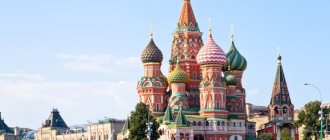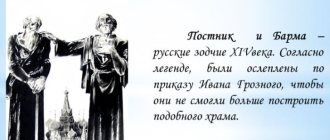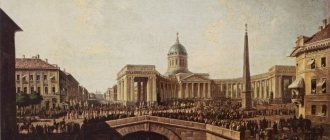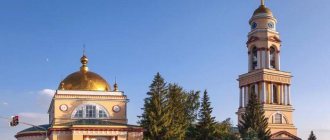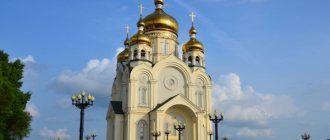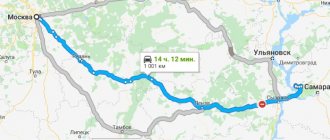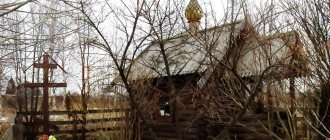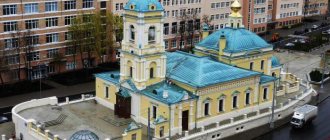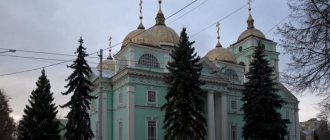"Save me, God!".
Thank you for visiting our website, before you start studying the information, please subscribe to our Orthodox community on Instagram, Lord, Save and Preserve † - https://www.instagram.com/spasi.gospodi/. The community has more than 60,000 subscribers. There are many of us like-minded people and we are growing quickly, we post prayers, sayings of saints, prayer requests, and timely post useful information about holidays and Orthodox events... Subscribe. Guardian Angel to you!
The Kazan Church of St. Petersburg is a cathedral Orthodox cathedral, which is located in the central part of the city with its facades facing the Griboedovsky Canal and Ave. Nevsky. In the Northern capital, the presented chapel is considered one of the largest buildings, the height of which approaches the mark of 71.5 m, and the streets leading from the sanctuary, the bridge located at the intersection of the Griboyedov Canal and Nevsky Prospect, were even renamed after him, and also an island in the Neva delta. You can find out in more detail about what history the Kazan Cathedral in St. Petersburg hides, opening hours, how to get to it and more - from this article.
Kazan icon - a symbol of protection in war
Its creation is connected with the main shrine of Rus' - the icon of the Kazan Mother of God, whose appearance to the world cannot be called anything other than a real miracle. The Russian soldiers, overshadowed by her holy image, accomplished many military and civil feats, including the most important of them - the liberation of the country from the Poles in the 16th century. It was before the face of the Kazan Mother of God that the militia prayed before the attack on besieged Moscow; a religious procession took place with her in October 1612. The icon played a great role in the victory over the Swedes in the Battle of Poltava (1609) and near Vyazma (1812) in the war with the French.
Architecture
The Cathedral of the Kazan Icon of the Mother of God is a typical example of temple architecture of the first half of the 17th century. This is a single-domed temple with two chapels. The northern and southern aisles are united by a gallery that surrounds the structure on three sides.
The exterior of the cathedral is decorated with mosaic icons in the Russian style. They depict the Mother of God, Jesus Christ, St. George the Victorious, the Patriarch of Moscow and other saints.
© Official website of the Moscow Patriarchate
History of construction
A memorial plaque on the wall of the cathedral announces the start of construction of the temple at the behest of Paul I in 1801 instead of the crumbling Church of the Nativity of the Virgin. Famous European architects took part in the competition for designs for the future temple, but the design of the talented genius architect Voronikhin, who did not participate in the competition, and was recommended by Count Stroganov, was taken as the basis. The laying of the first stone took place after the tragic death of Paul the 1st on September 8, 1801 in a solemn atmosphere.
Cathedral of the Kazan Icon of the Mother of God St. Petersburg
On Nevsky Prospect in 1710, not far from the wooden structure with the hospital, a chapel was erected, and a little later the wooden Church of Our Lady of Kazan was built. By decree of Empress Anna Ioannovna, a new stone prayer house was founded only in 1733 in September and was erected according to the drawings of M. Zemtsov, which later bore the name Rozhdestvensky. The newly erected church had a rather grandiose decoration, namely a multi-tiered bell tower reaching 58m in height.
The best article for you, go to: St. Basil's Cathedral in Moscow
The famous miraculous image of the Mother of God was transferred to this temple of God from the Trinity Sanctuary on July 2, after which the church began to be called by the name of the divine face and received the status of a cathedral, which later became the main Orthodox place in the Northern capital.
By the beginning of the 19th century, the temple building had become significantly dilapidated, so it was decided to build a new building. Paul I planned to build a temple similar to the Church of St. Peter, located in Rome, and already in 1799 a competition was announced for the best project for the future sanctuary.
Nearby was the residence of Count A.S. Stroganov, who subsequently proposed a project created by the young architect A.N. Voronikhin, who was previously a serf. The drawing presented by Andrei Nikiforovich was approved. The foundation of the new Church of God began in the presence of Alexander I, and Count Stroganov was appointed responsible for the construction work, which was completed by 1811. And the author of the architectural project itself was presented with the award of the Order of Anna, II degree, as well as a lifelong pension.
Another interesting fact is that only Russian craftsmen took part in the construction. The masons were led by Samson Sukhanov, while most of the builders involved were ordinary serfs who were forced to give all their earnings to the owners. They initially lived behind the garden in dugouts, and then after a while they moved to Konyushennaya Square in barracks.
The best article for you, go to: Cathedral of the Resurrection in Tver
To decorate the sanctuary, only high-quality domestic building materials were used: Riga limestone, Serdobol and Vyborg granite, Olenets marble, and for the outer covering of the walls - Pudozh stone brought from Gatchina.
Architecture and interior decoration
An unsurpassed masterpiece of architecture is made in the Empire style and repeated in many features the famous Roman Cathedral of St. Peter, as Paul 1 wanted. The appearance of the temple embodied the forms of Roman basilicas and Orthodox domed cross churches. The grandiose cathedral building, made of Pudozh stone (lime tuff), in the form of an elongated 4-pointed Latin cross in the center is crowned by a slender domed tower. The majestic facade colonnade repeats the architectural style of the Roman sanctuary. Outside, the facade of the temple is decorated with bronze statues of Orthodox saints and elegant bas-reliefs. The northern entrance (gate), designed like the “Doors of Heaven” of the Florence Cathedral, is made of bronze.
The internal design also corresponds to the parameters and forms of a Roman basilica: 4 rows of monolithic Corinthian columns made of granite divide the space into 3 naves (corridors). The splendor of the interiors, decorated with domestic natural stones, amazes the imagination. Decorative artists and sculptors (Pimenov, Martos, Demut), according to Voronikhin’s plan, used jasper, Karelian marble, porphyry, and calcareous tuff. Famous artists Bryullov, Bruni, Borovikovsky, Kiprensky, Shebuev decorated the walls with delightful paintings on religious subjects, genuine painting masterpieces.
Cathedral architecture
The temple was designed in the traditional ceremonial style of the 17th century. A large number of small carved details, the complexity and overlap of architectural elements became the harbingers of the emergence of a characteristic Russian style - uzorochye. The new building was erected on its original foundation, which was discovered during excavations. The building with one dome has a regular cubic shape and is a pillarless structure, when the dome and vaults are supported by external walls, and not by additional columns.
The facades of the building are decorated with a four-tiered hill of decorative kokoshniks, which is crowned with a white tower of a helmet-shaped dome. On the ground floor there is an additional gallery for parishioners, which is closed by three false arches on closed niches.
The design of the bell tower is simple. At the base there is also a cubic first level, above which rises an octagonal belfry. The height of the dome is slightly lower than the church dome to emphasize the secondary nature of the structure.
Colors and symbols
The facades of the building are painted in three main colors: gold, red and white. According to the Byzantine Orthodox tradition, each color has its own meaning. The golden color symbolizes God, red means righteous fire (punishing force), white means humility and sublimity above worldly vanity. In the 17th century, the military uniform of the Russian army was made in the same range, and the warriors of the apocalypse were also described in the Holy Scriptures.
It is impossible to recreate the interior of the church in its original form due to the lack of surviving descriptions and other documents. Craftsmen from Palekh and Bryansk were invited to create a unique iconostasis. Based on information about the subjects that were used in the painting of the cathedral in the 19th century, the artists created a unique composition.
Colonnade
According to religious canons, the entrance to the cathedral should be from the west, the altar should be in the east. Compliance with this rule made the temple turned sideways towards Nevsky Prospekt. To create the main entrance from the north, Voronikhin designed a monumental semicircular colonnade of 96 columns 13 meters high. Each Corinthian column made of lime tuff, ending with an intricate capital, individually is also an architectural masterpiece, embodying the filigree work of the builders.
What we couldn’t implement
Voronikhin’s ideas were not fully realized - the southern colonnade was not installed, but the northern one became an undoubted decoration of Nevsky Prospekt. The sculptures of the archangels Michael and Gabriel on the pedestals on both sides of the colonnade and the planned fence at the western entrance in front of the square are missing. Despite this, the colonnaded structure of the Kazan Church is not inferior in grandeur and beauty to Peter’s Cathedral in Rome.
Modern Kazan Cathedral
In 1801, the first stone was laid in the foundation of the new temple. The main participant in this ceremony was Alexander I, who, despite the fears of Stroganov and Voronikhin, did not abandon the idea of building a cathedral after the death of his father. For the new emperor, this was the first important matter that raised his authority among the people. Ten years later, the solemn ritual of consecrating the temple took place. Immediately after the services began, the old church was removed. From its very foundation, the cathedral was perceived by St. Petersburg residents as a symbol of the victories of the Russian army and a kind of “talisman” that helped them perform great feats and achieve heroic victories. It is no coincidence that after the end of the Patriotic War of 1812, it was here that trophies obtained in battles were brought - the banners of the defeated French armies. A little later, the ashes of Field Marshal Kutuzov found eternal rest here. The creation of the interior design continued for quite a long time, until 1829. Finishing work was carried out under the direction of O. Montferrand.
The life of the building is connected with many historical events. At the end of the 19th century, the funeral ceremony for composer P.I. took place in the church. Tchaikovsky. A little later, a big date was celebrated here - the 300th anniversary of the Romanov dynasty. By the way, this event is overshadowed by an unfortunate tragedy. At the time of the celebration, a stampede occurred, as a result of which more than 30 people died. The years of Soviet power were very difficult. In the 1920s, valuables related to religion in one way or another began to be confiscated throughout the country. The interior decoration and facades of the cathedral were damaged, but services in the temple continued until 1932. Then the Museum of the History of Religion and Atheism was opened here, as, indeed, in many churches in the country. In the 1950s-1960s, the cathedral was restored first inside, then outside. It began working full-time again in 1998, after the solemn consecration. In 2000, it was given the status of a Cathedral.
Architectural features of the Kazan Cathedral
Few people know that the modern Kazan Cathedral was conceived somewhat differently by the architect Voronikhin. The full project was never realized. According to the plan, a large-scale colonnade was to decorate the southern façade, located on the opposite side. However, the unfinished structure of the building did not spoil its appearance at all.
The structure itself has the shape of an oblong cross, its oblong part is parallel to the avenue. On the northern side, the façade of which faces Nevsky Prospekt, it is decorated with a semicircular colonnade. From the south, west and north, entrance gates lead into the cathedral, decorated with porticoes with columns. There are wide steps in front of them. The dome part is very original. The dome drum has a stepped structure, narrowing gradually as the height increases. It is divided into sectors, each of which has rectangular windows. There are also windows at the base of the dome itself, but they are round, framed by protruding platbands. The walls of the cathedral are not entirely typical: there are no large piers, and there are large windows in two rows on all facades. Between them the full height of the wall is decorated with pilasters. The cathedral is decorated with many decorative details: relief compositions, carved cornices, figures carved from stone. The cathedral building itself is not “conspicuous” at all, because from Nevsky Prospekt there is a stunning view of the main colonnade, consisting of 96 columns. Their height reaches 13 meters, they are located on a pedestal trimmed with Serdobol granite. The architect's compositional solution fits surprisingly harmoniously into the surrounding space.
Massive columns give the building genuine lightness, while at the same time incredibly emphasizing its grandeur. Unity with the dome part is created by the portico located in the center of the colonnade. The illusion is created that the dome is on a pedestal built above the portico. It is worth noting that from the southern, western and eastern facades the building itself and its domed part also combine surprisingly harmoniously. Unlike traditional Orthodox churches, the Kazan Cathedral attracts attention not with its domed part, but with its colonnade, which is not quite traditional for Russian architecture. The color treatment of walls and columns is also not very common. The main material used in their processing is Pudost light yellow stone, emphasizing the delicate, natural color scheme, combined with the blue of the sky and the silvery dome. There is one more difference: the Kazan Cathedral does not have a bell tower, but there is still a belfry; it is located in the western part of the colonnade.
Interior design
The interior decoration of Orthodox cathedrals was designed so that nothing would distract parishioners from prayer. The architect deviated a little from these principles; he was inspired by the creation of a unique urban ensemble. Inside, the cathedral resembles a palace hall, framed on all sides by columns.
The light coming inside from small windows in the domed drum adds to the effect of solemnity and tranquility. The structure amazes with its internal dimensions: width - more than 70 meters, depth - more than 55. In plan, the cathedral is an elongated cross, this served as a determining condition for creating the interior design. The main space inside is the dome part. It combines very organically with the vaults; a surprisingly laconic connection is achieved with the help of arches. The design of the dome drum, arches and vaults is made in the form of a sophisticated pattern of circles and semicircles. The floor here is very beautifully designed, its outlines follow the lines of the vaults. The decor is made with mosaic elements in the form of circles of decreasing diameter. The color of the details is chosen so that the relief effect of the picture stands out. There are a total of 56 columns inside the temple. They perform two functions: design and constructive. Their main task is to support the vaults. In the western part of the cathedral, their role in zoning the space is great. With the help of rows of columns it was possible to divide the room into 3 naves. The vaults in the side naves are much lower than in the central one. This made it possible to highlight the advantage of the central part. The altar part is arranged in a similar way. The architect brilliantly thought out the proportions of the interior decoration elements. Literally every little detail is important in creating the overall impression. The dimensions of the columns, windows, the height of the vaults, and the dimensions of the room itself are ideal in proportion. The floor in the temple is made using the mosaic method. To make it, stone of three shades of marble and dark red quartzite was used. The design in each individual part of the building is created in accordance with the principle of creating integrity in combination with the design of walls and vaults.
The lighting design with a natural light source turned out to be especially interesting. Due to the number and size of window openings, light enters the temple, which magically rushes upward into the dome part. This creates the illusion of being in a beautiful palace hall, where lightness, severity, splendor and simplicity are uniquely combined. In the middle of the 19th century, unique chandeliers made by Chopin appeared in the cathedral. They had a bronze-gilded coating and a huge number of candles. The diffused light emanating from them gives the overall interior softness, solemnity and special sophistication. The cathedral is unlike other Orthodox churches in one more way: it is not decorated with icons from top to bottom. There were three altars here, which were separated from each other by iconostases. The main one was modified several times. The architect Voronikhin, having built the central iconostasis in 1811, saw some discrepancy in its size and the dimensions of the altar part. Two more iconostases, the Nativity of the Virgin and Antonio-Feodosievsky, were erected in the southern and northern parts of the room. Their decor was lush and embossed. It stood out from the general design of the cathedral. In 1836, it was decided to create a new main iconostasis, more massive and strict. The architect K.A. worked on it. tone, creating a truly stunning creation. Having made the columns from malachite, silvered the main part, added strict reliefs and ornaments, the architect made changes to the side iconostases. The design of the Kazan Cathedral combines several different types of art. All the details are so thought out that hardly anyone can doubt that something was done incorrectly. It is immediately clear that the young but very talented architect put his whole soul into the main creation of his life
Svetlana Vorobyova specially for lions-guides.ru
Shrines
Having become the first European analogue of religious objects in Russia, the Cathedral of the Kazan Mother of God immediately after the Patriotic War of 1812 turned into a memorial repository of shrines and relics symbolizing important historical events of the state and the exploits of outstanding military leaders.
Monuments
Having attended a solemn prayer service in honor of the opening of the temple, M. V. Kutuzov immediately left here to take command of the army in the field, forever linking his fate with it. It was in the Kazan Cathedral that the body of the great field marshal was buried (June 1813). Five years later, Alexander I issued a decree on the erection of monuments to the brilliant commanders Kutuzov and Barclay de Tolly, which could only be fully implemented in 1837.
The sculptors Orlovsky, Galberg, the architect Montferand and the president of the Academy of Arts Olenin took part in the creation of the monument projects. The best were recognized as the sketches of Orlovsky, who managed to embody in the sculptures of the commanders their significant contribution to the victory over the French, the essence of the characters of each of them and their portrait resemblance. Both monuments are erected on granite pedestals, on which the names of military leaders are “written” in gold.
Sacred Relics
The main shrine of not only the Kazan Cathedral, but also of the entire Russian people is the miraculous Kazan Icon, which, according to legend, was found by 8-year-old Matryona in the ground under a burnt house. The girl was informed about the location of the icon, later immortalized by the monastery, by the Mother of God, who appeared to her in a dream. In addition to the Kazan Icon, icons of St. Nicholas the Wonderworker, the Savior, the Resurrection of Christ with a piece of the Holy Sepulcher are worshiped in the cathedral.
Behind a low bronze fence decorated with gilded wreaths, posts and corner pillars in the shape of cannon barrels is the sacred grave of Kutuzov. It is surrounded by conquered trophies, symbolizing the Russian victory over the French and the liberation of Europe: Napoleon's marshal's baton, banners and standards, keys to European cities and fortresses.
Miraculous icon
The Kazan Icon of the Mother of God, one of the most revered in the whole world, was revealed in Kazan on July 8/21, 1579. This holiday is celebrated annually by believers throughout Russia.
According to legend, after a terrible fire in Kazan, ten-year-old Matrona dreamed of the Mother of God, who indicated the location of the icon, where it was found, buried to a depth of about a meter.
Before moving to St. Petersburg, the icon was in the Kazan Monastery of the Most Holy Theotokos, founded by Ivan the Terrible in 1579.
The icon belongs to the Hodegetria type - the Mother of God is depicted frontally with the baby Jesus Christ in her arms. Because of its value and the precious setting of the image, the icon of the Mother of God was repeatedly subjected to thefts and attempts to destroy. To prevent loss, many copies were made.
Monument to M. I. Kutuzov on Kazan Square, © Tatyana Lisker
Schedule of services
The Kazan Cathedral - a place of spiritual purification, a meeting place with its shrines - is always filled with people coming to the services that take place every day. The cathedral opens on weekdays at 7 a.m., on Sundays and holidays at 6.30 a.m.
Divine services on weekdays
- First (Divine) Liturgy – 07.00. Confession starts at 7.30.
- Second (Divine) Liturgy – 10.00. Confession (start) – 10.30.
- Evening service – 18.00.
On Sundays and holidays
- First Liturgy – 7.00. Confession (start) – 7.30.
- Second Liturgy – 10.00. Confession starts at 9.30.
- Evening service – 18.00.
Every day in the cathedral between liturgies, solemn rites of baptism and weddings take place. Prayers are held and memorial services are served by prior arrangement.
How to get there
The Kazan Cathedral is located in the center of Moscow on Nikolskaya Street. Getting to it is not difficult - several metro stations and public transport stops are within walking distance from the shrine. You can also take a taxi or go by car.
Metro
The metro is perhaps the most convenient transport in the capital. From the station closest to the cathedral, “Okhotny Ryad” (red line), walk only about 100 meters from exit No. 7. In addition, the Teatralnaya station (green line) is nearby, and a little further “Revolution Square” (blue line).
Moscow metro map - Yandex. Metro
View of the cathedral from Nikolskaya street:
Public transport
300 meters away, near the Okhotny Ryad metro station, there are stops: Okhotny Ryad Metro and Manezhnaya Ploshchad. Buses and minibuses run here: No. M2 (to Rizhsky Station), M3, M10, M27, H1 (night to Sheremetyevo Airport), H2 (night), H11 (night to Vnukovo Airport), H12, 101, 144 , 904.
A little further (on the opposite side of Red Square, near St. Basil's Cathedral) there is another bus stop - “Red Square”. Buses No. M5 and 158 depart from it.
Moscow public transport portal
Sunday school for children and adults
The Kazan Cathedral is a center of religious education, where Sunday schools for children and adults are organized. The adult educational course lasts 3 years, but you can become a student at any time. Teaching is conducted by highly erudite clergy in the form of lively dialogues, scientific and educational lectures on the main issues of Orthodoxy. The program includes an introduction to the basics of the Law of God, the Catechism, the Old and New Testaments, the history of the Russian Orthodox Church, etc.
Class hours: Saturdays (September-May), 16.00-18.00.
Sunday School Program for Children
Children's Sunday school students are divided into 3 age groups: junior (5-7 years), middle (8-11), senior (12-17). The program includes the study of the Law of God (the basis of moral education), training in church singing (spiritual and aesthetic education). Children have the opportunity to show their talents in singing, visual arts, participate in various concerts, festive events, and make pilgrimages to holy places. A Sunday liturgy is organized monthly for students.
Timetable of classes:
- Sunday – from 12.00 to 15.30
- Tuesday - 1630 – vocal lessons (individual)
- Saturday – Art classes – 15.30, altar work (boys) – 17.00
Where is the Kazan Cathedral in St. Petersburg and opening hours
The Kazan Cathedral Church is considered an effective sanctuary of the Orthodox Russian Church of the Moscow Patriarchate. It is also worth noting that there are some rules established on the territory of the chapel, namely:
- Men, before entering the sanctuary, must remove their headdress, and women, on the contrary, cover their heads with a scarf or headscarf;
- it is forbidden to sit in an Orthodox chapel, except when a person is sick;
- you must speak quietly so as not to disturb other visitors to the cathedral;
- According to stricter canons, women wearing short skirts, trousers and cosmetics applied to their faces are prohibited from entering the pilgrimage.
Opening hours of the Kazan Cathedral in St. Petersburg
The prayer service is open to everyone from Monday to Friday from 07:00-20:00, and on weekends and holidays from 6:30 in the morning until 20:00 in the evening. The temple closes immediately after the evening service. Entrance is free, but if tourists want to listen to a tour, the sanctuary workers can conduct it for a donation.
The service schedule is as follows. During weekdays:
- 07:00 – divine chant (early hours), confession also begins at the same time;
- 10:00 – divine hymn (late hours), confession begins at 09:30;
- 18:00 0 evening service.
On holidays and Sundays:
- 07:00 – divine early chant, confession begins at 07:00;
- 10:00 – divine late hymn, confession held at 9:30 am;
- 18:00 – evening service.
The best article for you, go to: St. Andrew's Anglican Cathedral in Moscow
Divine services, weddings, baptismal sacraments, and memorial services are held in this temple every day. There is always a clergyman on duty in the temple. There is a parochial school for adults and a Sunday school for children, an art school and a reading room.
There is a program “The Orthodox Way of Belief”, which is aimed at educating the Orthodox in the church plan. Every year on the 12th of September, religious processions are held in honor of Prince Alexander Nevsky from the prayer service along Nevsky Prospect all the way to the Alexander Nevsky Lavra. With the patronage of the archimandrite of the church, clergyman Pavel Krasnotsvetov, pilgrimage services are held here.
Youth Club of the Kazan Cathedral
In our pragmatic, rather cynical times, it is not easy for young people to decide on moral guidelines and find the right path in life. The youth club of the Kazan Cathedral unites searching, caring Orthodox youth, striving to find answers to pressing questions of existence in the process of communication between themselves and representatives of the church.
Organization of club activities
The program of club meetings includes the following activities:
- discussion discussions of various topics, lectures
- meetings with extraordinary people, interesting contemporaries
- presentation of problematic films followed by discussion
- volunteer raids, pilgrimage trips
- theological education
- participation in Orthodox holidays
